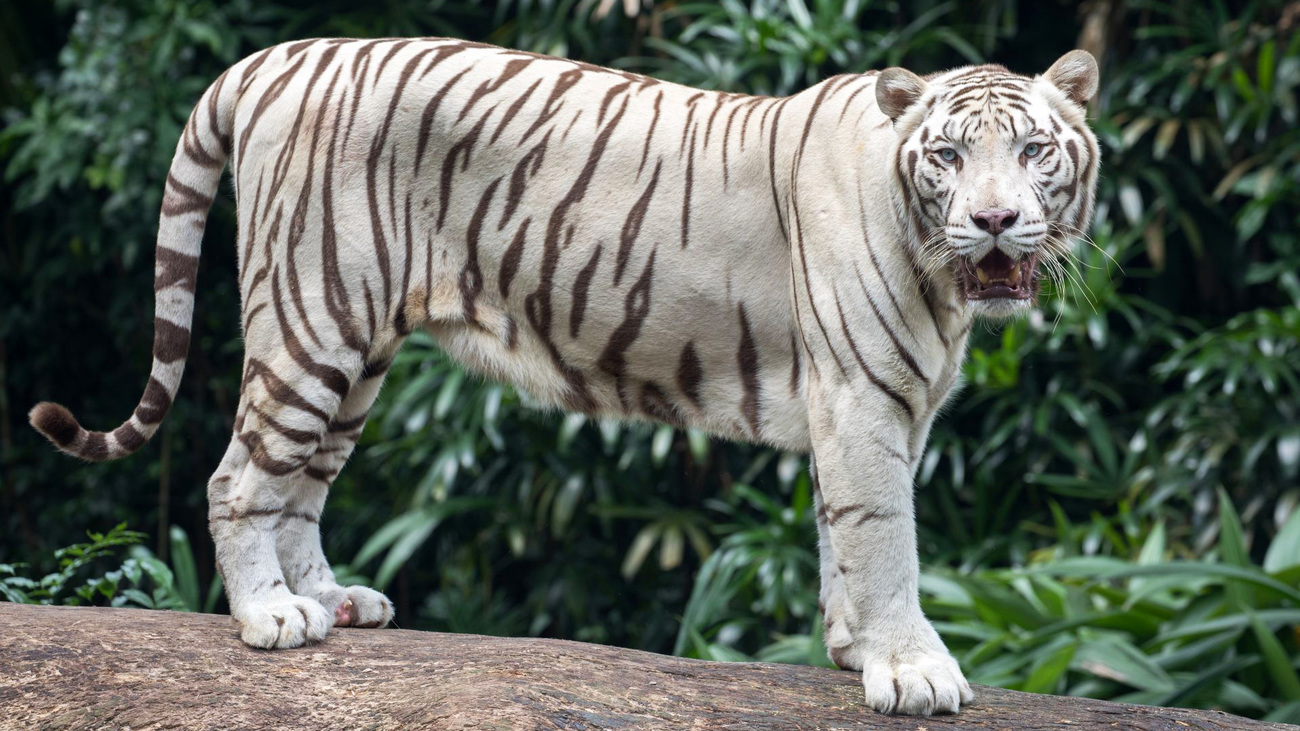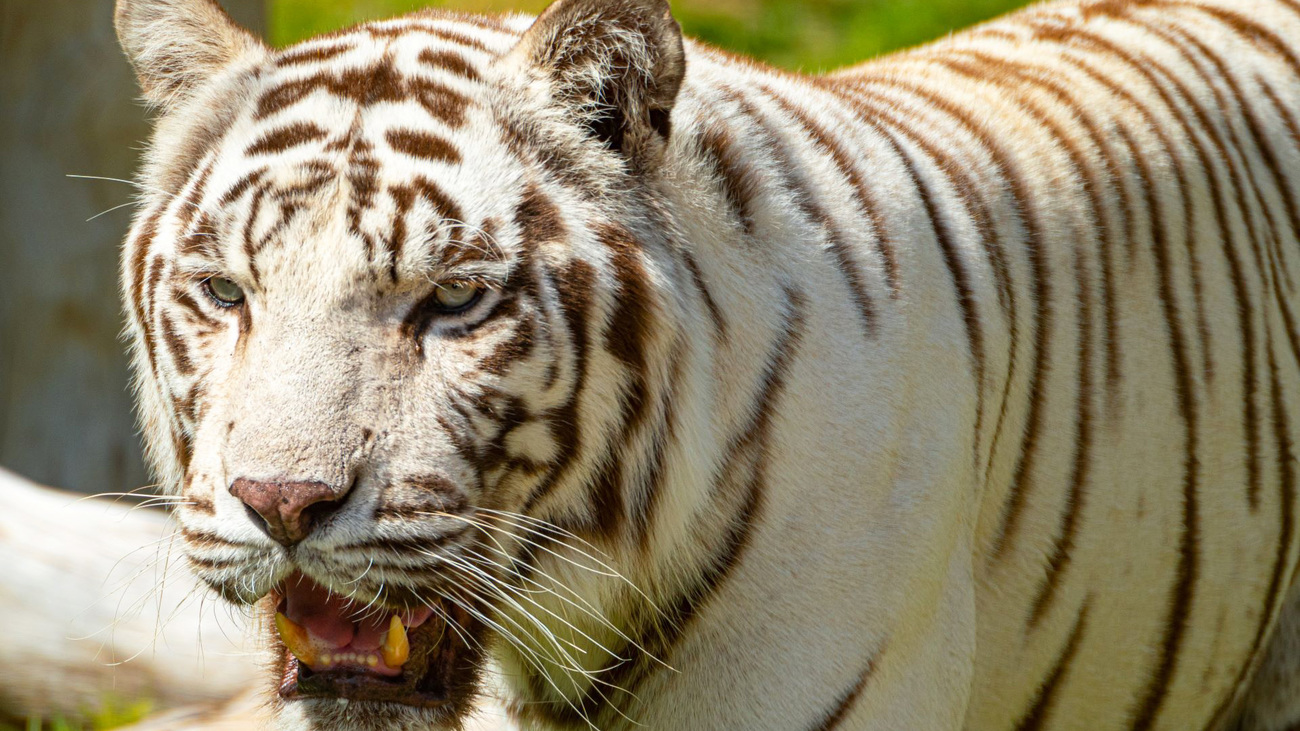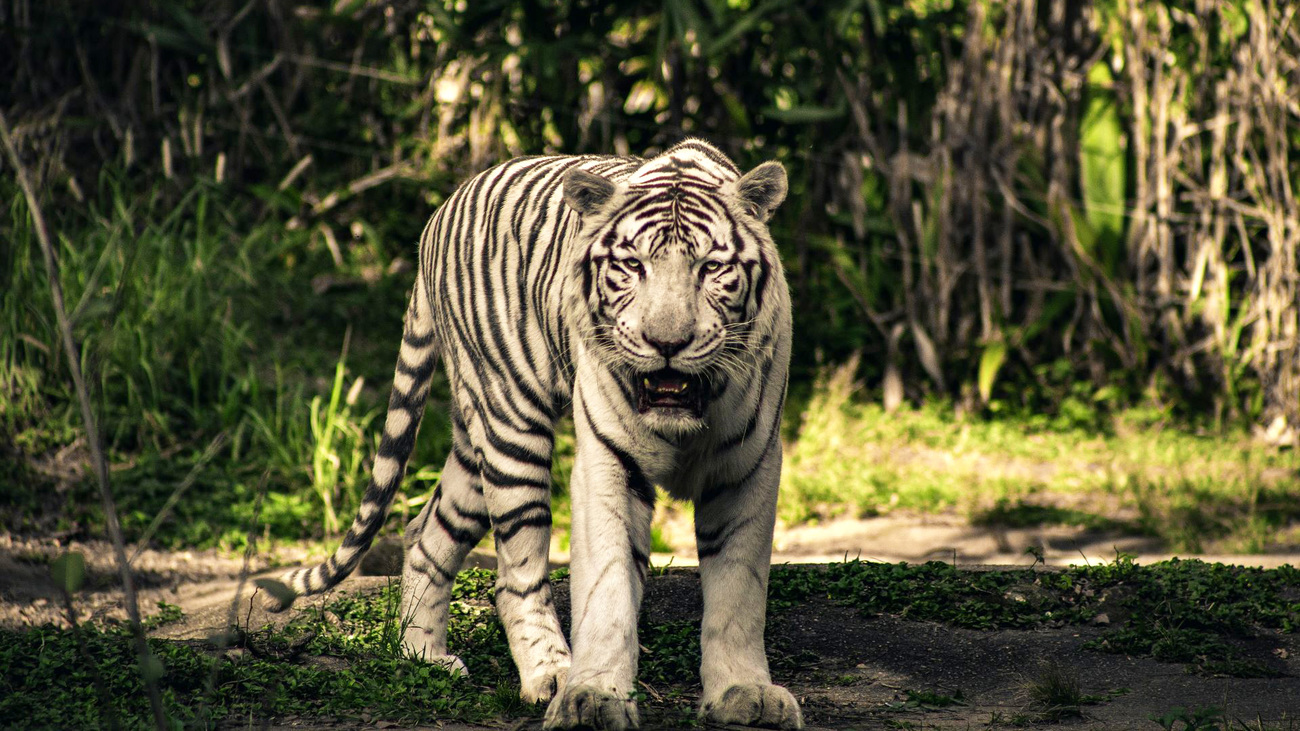White tigers
Contrary to popular belief, white tigers are not a subspecies of tiger, but rather a Bengal or Siberian tiger with a rare colour mutation called leucism. It is this recessive gene that causes a lack of pigmentation in the fur, resulting in its unique white coat.
Since their existence is the result of a rare mutation appearing in the wild approximately once in every 10,000 tiger cub births, white tigers are incredibly rare. Only a handful of white tigers have ever been spotted in the wild, and because their coat doesn’t serve as camouflage, most wild white tigers don’t survive into adulthood.
Instead, these animals only exist today because they are bred in captivity, a cruel and profit-fuelled enterprise.
In captivity, white tigers are the result of inbreeding, which results in cubs being born with severe deformities and medical conditions. They are bred in unregulated pseudo-sanctuaries with the sole aim of generating massive profit, with little regard for the health and wellbeing of the animal. One study even found that 80% of inbred cubs died shortly after birth.
The only reason these majestic animals are bred in captivity is for status and money—they serve no conservation or educational purpose. White tigers are incredibly lucrative, used by entertainers and private clubs for photo opportunities and, in some cases, are even sold as exotic pets.
Pop culture has romanticised the keeping of big cats as pets, and we need to put an end to this cruel practice. Read on to discover interesting white tiger facts and learn more about what we can do to help them.
What is a white tiger’s scientific name?
A white tiger is, scientifically speaking, a tiger with a genetic mutation, so it has the same scientific name as other tigers, Panthera tigris.
A Bengal white tiger is known as Panthera tigris tigris, while a Siberian white tiger is known as Panthera tigris altaica.
Are white tigers endangered?
White tigers are endangered, but not in the traditional sense of being listed on the IUCN Red List. They are (and should be) rare, as white tigers are the result of a one in 10,000 genetic mutation.
Instead, they are endangered because they are repeatedly captured and bred by trainers who cruelly keep them for entertainment purposes. These white tigers are often inbred, which results in poor health conditions (including deformities, heart defects, and crossed eyes) and a high mortality rate.
Where does the white tiger live?
White tigers are believed to be extinct in the wild—the last known wild white tiger was killed in 1958.
However, if they weren’t extinct in the wild, the white Bengal tiger would have the same habitat as regular Bengal tigers: the forests and wetlands of India, Bangladesh, Bhutan, and Nepal. The Siberian white tiger would similarly be found with other Siberian tigers, in far-eastern Russia and northeastern China.
White tigers live exclusively in captivity now, in zoos, circuses, rescue sanctuaries, and private residences. Around the world, there are an estimated 200 white tigers in captivity, half of which live in India.
Threats
White tigers are highly sought after in the illegal wildlife trade due to their rarity and perceived value. As such, white tigers face a number of threats, all of which are caused by humans. Their survival depends on concerted efforts to raise awareness of and stop inbreeding, pseudo sanctuaries, and the capturing of these animals for human entertainment.

Inbreeding
One of the most significant threats to white tigers is inbreeding. The only way breeders can be sure to produce more white tigers is through the inbreeding of tigers who already have the recessive gene. Breeders therefore often pair closely related white tigers together to produce cubs, which increases the cubs’ risk of genetic abnormalities and health issues.
Around 80% of white tiger cubs bred in captivity die very quickly after birth.
Captivity and human entertainment
White tigers are bred and kept in captivity for the sole purpose of human entertainment—they have no educational use. They are displayed in zoos, circuses, or private collections to attract visitors and generate revenue. More often than not, the conditions in these facilities don’t meet the animals’ natural needs.
Pseudo-sanctuaries
Pseudo-sanctuaries are establishments that claim to be rescue or conservation centres for wild animals (including white tigers) but do not prioritise the animals’ welfare or conservation. Instead, they exist solely to make money at their expense.
Most pseudo-sanctuaries are simply private zoos masquerading as animal rescue centres, breeding white tigers without proper consideration for their health or genetic diversity.
FAQs
Let’s explore some fascinating white tiger facts.

What is a white tiger?
A white tiger is a rare colour variation of the Bengal tiger or Siberian tiger. It stands out from its orange-furred counterparts due to its white coat and pale stripes, which are a result of a genetic mutation known as leucism.
Unlike albinism, which causes a complete absence of melanin and results in a white animal with pink eyes, leucism only affects pigmentation in the fur. The chances of a white tiger occurring in the wild are about one in 10,000.
What does a white tiger look like?
Unlike the typical bright orange fur of its relatives, a white tiger’s coat is a striking shade of pure white, with faint to light grey stripes that adorn its entire body. Its eyes are often a piercing blue or green, a colour combination that makes them visually striking. The white tiger’s rare beauty contributes to its popularity among breeders and trainers, which is part of the reason why they are endangered.
What does a white tiger symbolise?
In various cultures and contexts, tigers hold deep symbolic significance and are often associated with power, strength, and grace.
Because of their striking appearance and elusive nature, white tigers are also associated with mystery and enchantment. Their rarity and vulnerability highlight the importance of conservation and symbolise the need to protect endangered species.
What is a white tiger called?
White tigers also go by various other names: white Bengal tiger, white Siberian tiger, royal white tiger, bleached tiger, or snow tiger.
How big can a white tiger get?
White tigers are not their own separate species, so they share the same physical characteristics as other Bengal and Siberian tigers. The Siberian tiger measures up to 4 metres long, while the Bengal tiger is smaller, around 2.2 metres long. The average white tiger is between these two sizes.
How much does a white tiger weigh?
White Bengal tigers weigh between 160 and 230 kilograms (350 and 500 pounds), while white Siberian tigers—which are bigger and heavier, as they live in colder habitats and need to store more fat—weigh up to 300 kilograms (660 pounds).
How fast does a white tiger run?
White tigers, like other Bengal and Siberian tigers, are incredibly fast runners. They can reach speeds of up to 40 miles per hour (65 kilometres per hour) in short bursts. This incredible speed is essential for hunting, as tigers need to close in on their prey quickly to ensure a successful catch.
How long can a white tiger live?
In the wild, one in every two white tiger cubs does not survive into adulthood. Their white coats are a deformity that makes them far more vulnerable to prey.
In captivity, a white tiger can live for approximately 20 years. However, the majority of white tigers suffer from a multitude of health problems due to their genetic inbreeding. These can include immune system deficiencies, scoliosis of the spine, hip dysplasia, neurological disorders, cleft palates, and protruding, bulging eyes.
Often, the tigers suffering from these afflictions are kept away from the public eye so breeders can maintain the image that their white tigers are strong, beautiful animals that thrive in captivity.
Only one in 30 white tigers born in captivity is considered ‘suitable’ to perform.
Is a white tiger a carnivore?
White tigers are carnivores and follow the same eating and hunting patterns as other tigers. They live on a diet of large prey, including boar, goat, cattle, and deer.
How rare is a white tiger?
In the wild, white tigers are very rare, occurring only once in every 10,000 births. In fact, a wild white tiger spotting has not been recorded by a human since the 1950s.
Are there any white tigers left?
As far as scientists know, there are no white tigers left in the wild. However, there are an estimated 200 white tigers held in captivity.
Can you have a white tiger as a pet?
White tigers shouldn’t be kept as pets. The desire to hold and display white tigers for human entertainment is an extremely cruel practice that results in sick and injured animals.
There’s a narrative perpetuated by pseudo-sanctuaries that white tigers must be bred in captivity for the survival of their species—but this isn’t true. There is no educational or conservational reason to continue to breed white tigers. Instead, captive tiger cubs, especially white tiger cubs, only serve to generate large amounts of revenue for breeders and owners. It’s very rare for any of this money to go toward protecting tigers in the wild.
Our work
IFAW is dedicated to improving the lives of tigers all over the world—both in the wild and in captivity. We work closely with governments and local communities to protect these big cats, particularly in the forests and jungles of India.
In India, we work with the Wildlife Trust of India (WTI) in collaboration with Assam Forest Department to help protect tigers living in Kaziranga National Park. IFAW-WTI has been working in Central India for over a decade, mitigating human-tiger conflicts, allowing safe passage to moving tigers, reducing human pressures on already fragmented corridors, and integrating stakeholder support in conservation management of tiger habitats. IFAW-WTI has also worked to strengthen protection for these big cats amongst other species by capacity building frontline staff (rangers), providing legal and enforcement assistance to wildlife enforcement agencies, and conducting anti-snare walks in critical tiger habitats.
In 2018, we helped launch the Coalition to End Wildlife Trafficking Online. As part of the coalition, companies and wildlife experts from around the world came together to develop an approach to reducing wildlife trafficking online. Since then, online technology companies within the coalition have removed or blocked over twelve million online advertisements for endangered and threatened species, including tigers.
We work to protect tigers in the US too. In 2017, we established the Big Cat Sanctuary Alliance (BCSA), a network of sanctuaries that cooperate to ensure that captive tigers have a safe place to go when they are rescued. At the federal policy level, we also worked to pass the Big Cat Public Safety Act. This legislation, signed into law in December 2022, made private ownership of big cats and physical contact between the public and captive big cats illegal. As a result of these combined efforts, since 2003, we’ve rescued 189 captive big cats and placed them in legitimate sanctuaries.

Video
How can you help?
If you want to help us protect the last remaining white tigers on the planet, consider making a charitable donation. Your donations, which are 100% tax-deductible, go directly to our conservation projects and programs around the world.